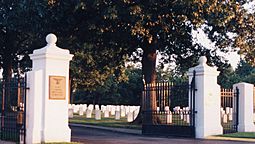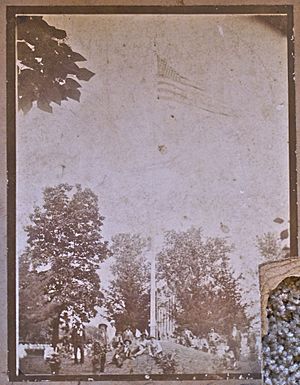Fort Gibson National Cemetery facts for kids

The Podge Cast
|
|
| Details | |
|---|---|
| Location |
1423 Cemetery Road
Fort Gibson, Oklahoma |
| Size | 48.3 acres |
| No. of interments | >25,000 (2021) |
Fort Gibson National Cemetery is a special place in Fort Gibson, Oklahoma. It is a United States National Cemetery. This means it is a burial ground for military veterans and their families. The cemetery covers about 48 acres. As of 2021, over 25,000 people are buried here. It is located in Muskogee County, Oklahoma.
Contents
History of Fort Gibson Cemetery
Fort Gibson was first set up in 1833. It was built on land that belonged to the Cherokee Nation. This area is known as the end of the Trail of Tears. Life on the frontier was very tough. Diseases like yellow fever were common. Because of this, at least three different cemeteries were created between 1833 and 1857. The Fort was then left empty for a while.
In 1863, Brigadier General James G. Blunt brought soldiers back to the Fort. In 1868, the National Cemetery was officially created. It started as a 7-acre plot of land. All the graves from the nearby older cemeteries were moved here. This included the remains of many regular people, not just soldiers.
Fort Gibson National Cemetery was recognized as an important historical site. It was added to the National Register of Historic Places on May 20, 1999.
Important Monuments at Fort Gibson
- A cenotaph for Corporal John Haddo. A cenotaph is a monument built to honor someone whose body is buried somewhere else. Corporal Haddo received the Medal of Honor. This is the highest military award for bravery. He earned it during the American Indian Wars in Montana Territory. He is buried in a mass grave at Little Bighorn Battlefield National Monument.
Notable People Buried at Fort Gibson
Many important people are buried at Fort Gibson National Cemetery.
Medal of Honor Recipients
These individuals received the Medal of Honor for their incredible bravery:
- John Haddoo (1851–1877): He was honored for his actions during the American Indian Wars. His cenotaph is at Fort Gibson.
- First Lieutenant Jack C. Montgomery (1917–2002): He received the Medal of Honor for his bravery in World War II.
- Private First Class John N. Reese Jr. (1923–1945): He also received the Medal of Honor for his actions in World War II.
Other Notable Individuals
- Captain Sonuk Mikko (Billy Bowlegs) (c. 1810–1859): He was a leader of the Seminole people. He fought for the Union side during the American Civil War.
- Paul "Buddy" Burris (1923–2007): He was a professional football player.
- Joel Elliott (1840–1868): He was a soldier and officer during the American Civil War.
- Theodore M. Risenhoover (1934–2006): He was a United States Congressman. This means he was a representative for his state in the U.S. government.
- Vivia Thomas (?–1870): There is a local legend about Vivia. The story says she was a brave woman who traveled alone to Fort Gibson. She was looking for a soldier who had been assigned there. The legend says she dressed as a man to make the journey. She later became ill and died. She is remembered for her adventurous spirit.


